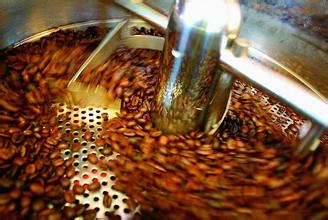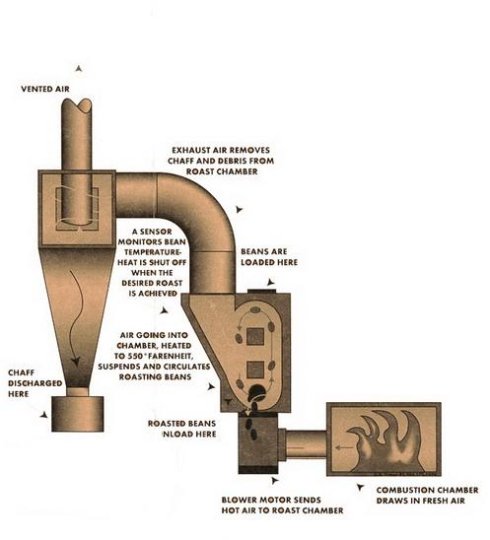Coffee roasting degree resolution chart the technology of roasting degree of raw coffee beans and the introduction of baking color
American Coffee Association (SCAA) roasting standard this standard uses infrared caramelization tester technology (Agtron) to measure the color of coffee beans to determine the roasting degree of coffee, and the color is divided into eight equal parts into eight standard color blocks for coffee industry as roasting identification.
The above colors are only for reference according to the roasting degree preferred by each country, which is also the earliest distinction of coffee roasting degree. Because different countries and regions have different taste preferences for coffee roasting degree, it is known as roasting degree by country or region, such as Italian roasting, French roasting and so on. However, the baking degree of these different preferences are integrated and arranged from shallow to deep to form the distinction index of baking degree, but because the standard is too general, different bakers have different identification of baking degree.
The above colors are only for reference to the distinction between the usual baking degrees in Taiwan in recent years, most of them lock in the changes in the sound of baking to determine the degree of baking.
Bean time point under baking degree-shallow baking (light) one explosion dense medium baking / city (medium/city) first explosion and second explosion deep city (full city) second explosion beginning meaning After the second explosion of Italian/French / French
The roasting of ◎ coffee releases the aroma of coffee through the burning of the fire, spilling out the sour, sweet and bitter taste of ─ contained in each bean incisively and vividly, from insipid raw beans to the endless aftertaste of mellow ─ roasting in the cup, it is the most important station for every coffee bean to outline its character and give birth to fragrance during its long journey. Whether in a professional roaster, on your own fire or in the oven, coffee beans have to go through many chemical changes during this 12-16-minute conversation with a hot cut at a temperature of up to 450C, making a second popcorn-like crisp sound and losing 15% ─ 25% of water. Baking process, like popcorn full of fragrance and joyful bouncing sound. From raw beans, light roasting to deep roasting, the water is released again and again, the weight is reduced, but the volume slowly expands and bulges, the color of coffee beans deepens, the fragrant oil is gradually released, and the texture becomes crisp. Raw beans ─ each coffee cherry contains two raw beans, and the fragrance is still deep in it, waiting to be discovered. Raw beans contain a lot of chloric acid, which disappears with the baking process, releasing familiar and pleasant fruit acids such as acetic acid, citric acid, and malic acid found in wine. Baking is just right to present these beautiful sour tastes in moderation, while if you bake them too much, they will be completely masked. When baked for 5-7 minutes, the beans begin to release water, changing from light green to orange, emitting the unique aroma of creamy roasted vegetables. Light baked ─ when the beans make the first light sound, the volume expands at the same time, and the color changes to a delicious cinnamon color, so it is also called cinnamon raost or half-city roast. Acidity dominates the flavor of shallow roasted beans, texture and taste have not been brought into full play, so they are generally used as canned coffee, can not meet the real coffee experts. When roasted in medium ─ for 10-11 minutes, the coffee beans are elegantly brown. New Yorkers like to start each day by roasting coffee beans with fragrant milk and sugar at breakfast, so this method of baking is also called breakfast roast or city roast. Medium roasting can not only preserve the original flavor of coffee beans, but also moderately release aroma, so Blue Mountains, Colombia, Brazil. Wait for a single cup of coffee, choose this kind of baking method. At 12-16 minutes, the oil begins to surface, and the beans are burned to a bright dark brown, called full-city roast. Some people think that the sour, sweet and bitter taste of coffee reaches the perfect balance, and the character of coffee beans is clearly carved out. The darker the color of deep-roasted ─ coffee beans, the sweeter the flavor, when the oil has been turned into caramel, bitter, endless aftertaste, the most suitable for brewing strong Espresso coffee, so it is also called Italian roasting. Moderate roasting gives life to the coffee beans and turns into an intriguing sour, sweet, bitter and astringent taste. However, people who are sensitive to caffeine might as well choose deep-roasted beans as much as possible, because caffeine will slowly escape during roasting, so the deeper the roasted beans, the lower the caffeine content ● Note: the sour and bitter taste of roasted degree will still vary from coffee to coffee. Tasting advice is only a personal opinion, and the main way to drink varies from person to person.
Source:
Barista-HHC 's blog
Important Notice :
前街咖啡 FrontStreet Coffee has moved to new addredd:
FrontStreet Coffee Address: 315,Donghua East Road,GuangZhou
Tel:020 38364473
- Prev

The basic chemical reaction that occurs during coffee roasting. The ingredients produced by the degree of coffee roasting.
Basic chemical reactions that occur during coffee roasting author: Carl Staub originates from the SCAA baking color classification system, developed by Agtron SCAA 1995 original text from: http://www.sweetmarias.com/roast.carlstaub.html translation: Grant, http://www.baristacn.com/forum/thread-1583-1-1.html in the roasting process
- Next

Theoretical roasting of coffee beans and the relationship between roasting and high-quality acid effect of inferior chlorogenic acid on coffee quality
In addition to the degree of baking is divided into factions, even the roaster also has a family view. At present, there are two major professional roasters, one is the traditional rolling furnace (Drum Roaster), and the other is the newly developed hot gas furnace (Air Roaster). The former is heated by gas across the bottom of the furnace, while the metal blades in the furnace keep stirring the beans, while the latter bakes the beans with high-temperature hot air flow.
Related
- What is the meaning of lactic acid fermentation with coffee bean treatment?
- How to judge the state of foam by sound?
- How does the latte pull out the unicorn pattern? Come to get for a little trick to improve the flower pull!
- Will flower pulling affect the taste of the latte?
- Do you know the history of coffee?
- The difference between honey treatment and sun washing what is raisin honey treatment?
- What kind of milk can a novice use to make coffee foam to keep the foam longer? The correct method and skills of milking tutorial sharing
- Why do washed coffee beans taste sour? Flavor characteristics of washed Coffee
- Introduction to the skill of how to practice the size and height of water injection around the circle of hand-brewed coffee
- How do beginners practice coffee flower drawing from scratch?

